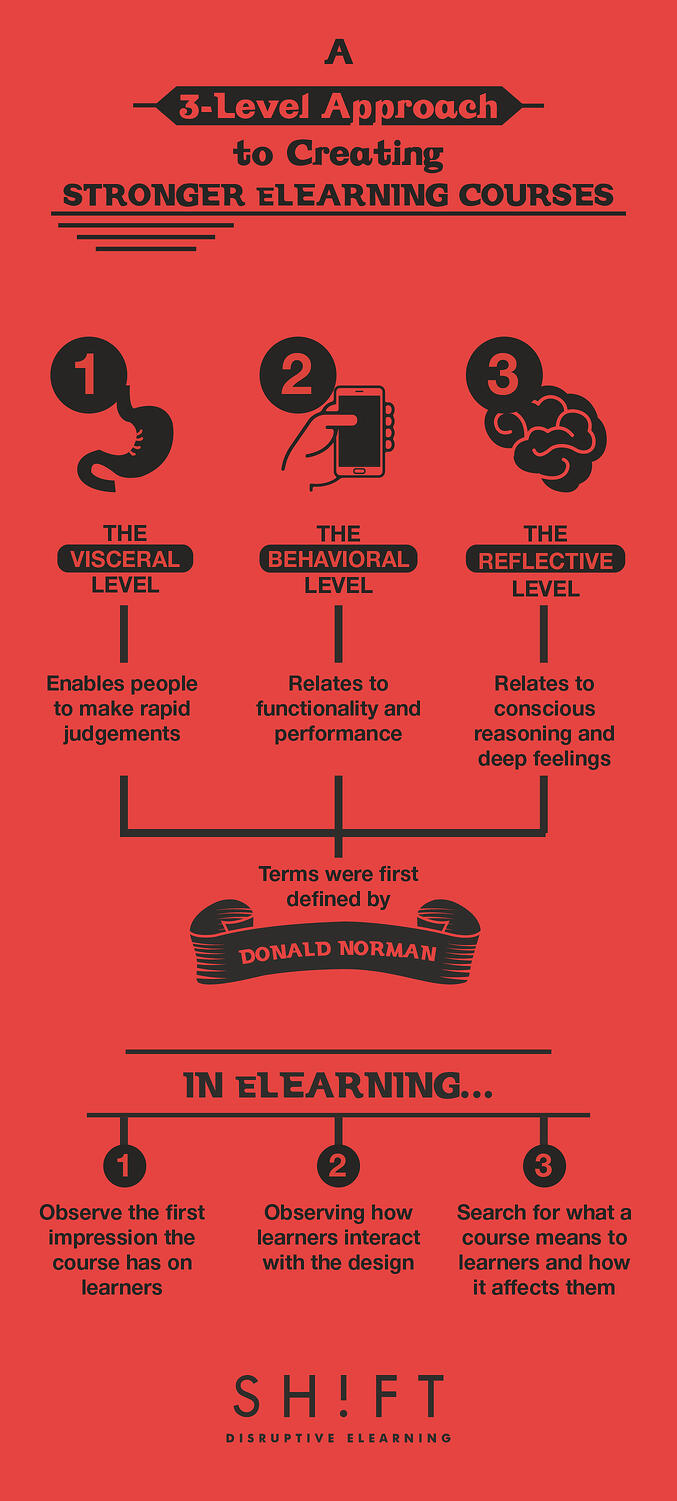Some eLearning developers tend to focus on their courses’ appearance; others place a greater emphasis on content. However, only a few, work on creating an effective eLearning design that has an impact on learners by evoking emotions and causing a lasting impression. This is called emotional design.
The best way to achieve an emotional design in eLearning is by paying attention to the three cognitive levels, first defined by Donald Norman — visceral, behavioral, and reflective. When utilized to create an effective eLearning design, these levels enable learners to form a connection with a course, which subsequently leads to a more appealing, pleasurable, and memorable learning experience.
It is important to focus on emotional design from the very start of course development; it is not something that can be infused into the program at a later stage. Emotional design must be present in every function, feature, layout, and language choice — from the typography and color palette to content and graphics.
This best way to understand how to apply emotional design is to look at the three cognitive levels in turn.

1) The Visceral Level (Appearance)
The visceral level, the automatic, prewired layer, the first and most base cognitive process, enables people to make rapid judgements. During this stage, appearance, rather than functionality, makes an initial and immediate emotional impression in the preconscious mind. The instinctive reaction this has depends on the personality and cultural values of the learner.
eLearning developers can test the visceral quality of their courses by observing the first impression it has on learners. An effective eLearning design on a visceral level will spark some sort of positive emotion, grabbing learners’ attention immediately, and sparking interest in users within those three vital seconds of a first glance. Therefore, any course that is aesthetically pleasing will be successful at this cognitive level.
2. The Behavioral Level (Usability)
The behavioral level, the part that contains the brain processes that control everyday behavior is the mid-level of emotional design and relates to functionality and performance. This cognitive process kicks in after learners surpass the first-impressions stage and move on to see how easy it will be to accomplish a task.
At this level, usability is fundamental; design must be intuitive and easy to use to avoid learners experiencing negative emotions such as confusion and frustration. An effective eLearning design at this level requires developers to understand users’ needs, achievable by observing how learners interact with the design.
If learners have a bad experience at the behavioral level, they will develop a negative emotion toward the course no matter how good other aspects, such as appearance and content, may be. This increases the likelihood that they will drop the course.
3. The Reflective Level (Impact)
The final level of cognition occurs after visceral and behavioral processing is complete. The reflective level is the highest level of cognition in humans. It relates to conscious reasoning and deep feelings and allows learners to overrule automated behavior and emotional impact.
In eLearning, the reflective level centers on what a course means to learners and how it affects them; for instance, a positive impression will encourage learners to complete the course, while a negative experience may lead them to seek out another option. Factors that influence this decision include self-image, memory, meaning, and perceived value, which is particularly important with learners, who tend to have short attention spans.
In short, effective eLearning design should evoke positive emotions and create a lasting impression on your learners. If learners feel safe, happy, and fullfilled, they will actually enjoy learning.By participating in courses that are successful on a reflective level, users form an attachment to the course, are proud to take part in the program, and experience enjoyment. Such success also increases the likelihood that they will recommend the course to others.
To Conclude
Effective eLearning design requires the above three elements work together to address the three cognitive levels that occur within the human brain. Cognitive processes on the visceral level take place instantly by drawing in learners through the visual appearance of a course. Behavioral level processes start acting after users begin to interact with the program. Finally, reflective processes have a long-term impact. Paying attention to all three when working on eLearning design ensures that users enroll in a program and then keep coming back to learn more.









